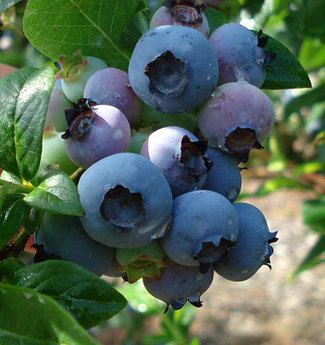Table of Contents
Selection and storage
In the United States, blueberries can be readily available in the markets year-round. However, fresh wild berries are at their best from June until August when their harvest season begins in Michigan and Maine in the USA and Quebec province in Canada.
In the stores, look for fresh berries that are firm, plump, smooth-skinned, with a silver-gray surface bloom. Buy deep purple-blue to blue-black berries. Avoid soft or shriveled, over-handled, bruised berries and those with signs of mold and old stock.
Once at home, place the berries in a plastic or zip pouch and store them inside the refrigerator set at high relative humidity. Stored thus, they stay well for up to a week.
Preparation and serving tips
Blueberries are sweet, juicy, and stain mouth deep-blue. Trim away any stems and leaves if you have purchased berries directly from the local farmer.
They are better enjoyed fresh after washing in cold water. If taken out from the cold storage, place them in a bowl of water to bring them back to normal room temperature, which enriches their taste and palatability. Gently pat dry using a moisture absorbent cloth/paper and enjoy!
Here are some serving tips:
-
Traditionally, blueberries have been part of the food culture of the Native Americans.
-
While fresh berries are eaten as they are like in table grapes, dried ones added to soup, stews, and to sweeten venison meat.
-
Dry blueberries are one of the most preferred items in the preparation of muffins, pies, and cheesecakes.
-
They are also a favorite addition to fruit salads, fresh fruit tarts, and ice-creams.
-
They can also be employed to make juice, sauce, jellies, and jams.
Safety profile
Blueberries may often cause severe allergic reactions in sensitized individuals. Often, these kinds of reactions occur because of
possible cross-reactions to other berries (strawberry), pollen, or weed allergies. Some of the most common symptoms of blueberry
allergy may include swelling and redness of mouth, lips, and tongue, eczema, hives, skin rash, headache, runny nose, itchy eyes, wheezing and gastrointestinal disturbances. Individuals who suspect an allergy to these fruits may want to avoid eating them. (Medical disclaimer).
≻≻-Back to Fruits from Blueberries nutrition. Visit here for an impressive list of all variety of fruits with complete illustrations of
their nutrition facts and health benefits.
≻≻-Back to Home page.
Further resources:
-
Refer Stanford School of Medicine Cancer information Page- Nutrition to Reduce Cancer Risk (Link opens in new window).
-
Blueberry and anti-oxidant activity- Phytochemical Properties and Antioxidant Activities of Extracts from Wild Blueberries and Lingonberries (Link opens in new window).





More Stories
United Healthcare’s ransomware attack shows why supply chains are under siege
Nutrition Tips For Ramadan | JM Nutrition
Probiotics for IBS | The Nutritionist Reviews